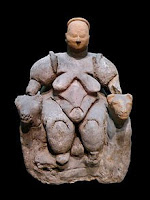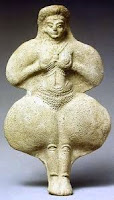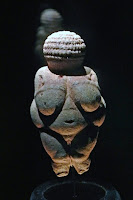 |
| Pietà by Michelangelo |
A Symbol of Earth's Fertility
 |
| Mother Goddess with Snakes |
Goddess figures are often found in shape of human or animals such as snakes, bulls, birds, etc. One of these figurines is Mother Goddess which is the main symbol of earth's fertility as well as creativity, birth, sexual union, nurturing, and the cycle of growth. The figurines of Mother Goddess can found in several shapes for different societies. Because each culture has not taken same maternal symbolism for depicting their deities.
Mother Goddess Figurines Among Societies
 |
Mother Goddess Cybele
|
These primordial goddesses can be discovered in large variety of locations due to the societies of early humans such as Mesopotamians, Cretans, Egyptians, Greeks, the Aegeans, and southern Europeans. Although every single society renamed it, they had not made significant differences in terms of characteristics of the figurines. In an example, the Mother Goddess was called as Cybele in Phrygia and Lydia.
 |
Mother Goddess Ishtar
|
 |
| Mother Goddess Isis |
Among the Babylonians and Assyrians, she was identified as Ishtar, in Syria and Palestine she appeared as Astart. For the Egyptians she was Isis, in Greece she was variously worshiped as Gaea, Hera, Rhea, Aphrodite and Demeter, in Rome she was identified as Maia, Ops, Tellus, and Ceres. Likewise, Virgin Mary is equivalent of the Great Mother figure in Christianity if the case is disclosed form the perspective of monotheistic religions. You may read the article about pagan symbols in Christianity.
Periodic Aspect
 |
| Mother Goddess Talaria |
This large variety of Mother Goddess existence in different cultures also may be a clear proof of early homo sapiens which were our ancestors could have had some spiritual beliefs. To continue, determining the characteristics of Mother Goddess related figurines and sculptures found in Europe and Anatolia from the Prehistoric period is a goal. In Prehistoric period, palaeolithic female figurines which refer to Mother Goddess were mostly in shape of human-animal mixed which is called as therianthropic. This shape refers to the earth's fertility in a large variance.
Relation with Hunter-Gatherer People
 |
Mother Goddess
from Neolithic Period
|
Palaeolithic figurines have to be seen within the context of animism which is relevant to the natural world. People whose different mind-set of the period viewed the world as a living organism which was inseparably completed with human being. Throughout the history of hunter-gatherer people, many drawings concerning shamanism world have been made. Both of them, shamans and the cave artists were probably the same people, most likely females during the Late Palaeolithic.
 |
| Mother Goddess Aphrodite |
For early homo sapiens, art was highly purposive and a powerful tool for communication. Paintings and figurines found in Palaeolithic caves were not merely some depictions of everyday animal life around the artist. Palaeolithic art and figurines are not mundane, because they represent integral components of a ritual and magical life for early humankind. As archaeologically, female mother figurines are popularly known as Venus which has been determined in respect to an extensive time scale from various regions, with considerable variability in form, style, decoration and context. These carved Venuses from the later palaeolithic period are generally women representations which carry small paintings on the surfaces and usually have gross bodies when it’s compared with nowadays sense of beauty. Besides sculpts, those depictions can largely be found as mural paintings on the walls of caves and shelters. In the later palaeolithic period, rituals were counted as life giving ceremonies concerning female figurines. Those rites also carry the meaning of worshiping to the goddess which is intertwined with the souls of deads. To sum up briefly, even if characteristics and types of Mother Goddess figures can vary due to the society, period and location, there is no doubt that each cults have attributed earth's fertility to them.








 Reviewed by Articonog
on
December 21, 2019
Rating:
Reviewed by Articonog
on
December 21, 2019
Rating:
 Reviewed by Articonog
on
December 21, 2019
Rating:
Reviewed by Articonog
on
December 21, 2019
Rating:





No comments: